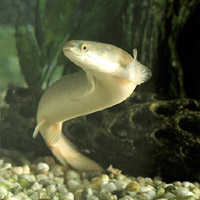Fishes - Electric Eel
 Region:
South America Region:
South America
Class: Osteichthyes
Order: Cypriniformes
Family: Electrophoridae
Genus: Electrophorous
Scientific Name: Electrophorus electricus
Description: Eel-like fish (not a true eel) with electric
organs; dorsal and ventral fins absent; anal fin very
long, united with caudal fin to form a single fin which
does not extend on to the dorsal surface of the body.
Scales absent. Colouration uniform olive brown, underside
of head and throat of adult is brilliant orange; eyes
shining green. Length: up to 2.9 metres
Distribution: Northern part of South America. Greatest
prevelance in the Amazon Basin.
Habitat: Shallow, muddy pools along creeks and rivers.
Food: Lives on freshwater shrimp as a subadult, changing
later to fishes and frogs. The electric eel is toothless
and swallows food whole.
Reproduction and Development: Practically nothing is known
about the breeding. They disappear from their usual Amazonian
haunts during the breeding season. Later, when they return,
one of the parents takes care of the young until they
are 10 to 15 cm. (4-6 ins.) in length. They have not yet
been bred in captivity.
Adaptations: The electric eel has markedly degenerate
gills that play no significant part in its respiration.
The uptake of oxygen occurs in the mouth, which is almost
entirely lined with paillae (protuberances) that provide
a large total surface area for gas exchange. Comparatively
little carbon dioxide is released through the mouth; most
of it is discharged into the water by way of the skin
and the vestigial gills. Experiments have shown that the
electric eel is responsive to the oxygen content in the
air. When it is subjected to air that is low in oxygen,
it speeds up its breathing efforts; when the air is abnormally
high in oxygen, the fish's breathing slows down. In all
fishes, the electric organs are derived from muscle cells.
The thin, flattened cells of electric organs are known
as electroplaques. Each cell is imbedded in a transparent
gelatinous material. In the electric eel, the organ is
arranged in columns of electroplaques which run longitudinally
and make up a large portion of the animal's mass. All
the viscera lie in the general region of the head (can
be about 1/5th of the body length). The electroplaques
along the body of an electric eel discharge simultaneously
(within a period of 3 milliseconds). Power is released
by the central nervous system (voltage as well as intensity).
Although the charge lasts only two or three thousandths
of a second, it can be repeated up to 150 times an hour
without visible fatigue on the part of the eel. Lying
motionless in the water, the eel is usually electrically
inert but when it begins to move, it emits small direction
finding impulses at a frequency of about 50 per second.
Threats: The electric eel has no enemies other than man
and is among the most feared fish in South America.
Status: Common
References: Animal Life Encyclopedia Vol. 1 and 2. Dr.
Bernard Grzimek Scientific American Magazine. Oct. 1968.
Article by Kjell Johansen |
|
|
